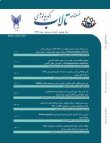Concentration of heavy metals in Avicennia marinaand sediments in Dayyer port
Author(s):
Abstract:
By increasingthe industrial activities during recent years and organic and inorganic pollutants including heavy metals to environment, especially in the aquatic ecosystems the problems that threaten human health are increasing. Aquatic plants that link of food chain have important role in the uptake of heavy metals. In this study, to determine the heavy metals (Cd, Pb, Cu, Ni and Zn concentration) and role of mangrove (Avicennia marina) in the accumulation of elements, samples collected randomly from sediments and plant tissues in three stations in Bardestan. Then,Metals concentration was measured by atomic absorption after acid digestion. The ammount of cadmium, lead, copper, nickel and zinc in the sediments was 4.5, 11.55, 10.30, 81.45 and 41.48 µg/g, respectively. The amount of these elements in plant roots was 2.89, 9.38, 6.17, 5.32 and 23.33 and in the sheet being 2.26, 8.78, 4.42, 2.39 and 15.37 respectively. In general, the accumulation of metals in sediments and mangroves tissues showed that increasing the amount of these elements in sediments can also increased concentration of metals in plant tissues, so, A.marina can be an indicator for heavy metals. In addition, this plant can indicate the amount of metals bioavailability and environmental hazards.
Keywords:
Language:
Persian
Published:
Journal of Wetland Ecobiology, Volume:5 Issue: 4, 2014
Pages:
45 to 55
https://magiran.com/p1684357
سامانه نویسندگان
مقالات دیگری از این نویسنده (گان)
-
Estimation of production and carbon stock of Gowatr mangrove forests, Gulf of Oman using PnET-CN model
Matin Khaleghi *, Ahmad Savari, , Mohsen Hamidian Pour, Sadroddin Ghaemmaghami
Journal of Marine Science and Technology, -
Microplastic pollution in two zooplankton groups on the southern coast of the Caspian Sea
Y. Azadkar Langroudi*, N. Sakhaei, F. Amini, S. Bagheri, A. Safahieh
Iranian Journal of Fisheries Sciences, Jan 2024



